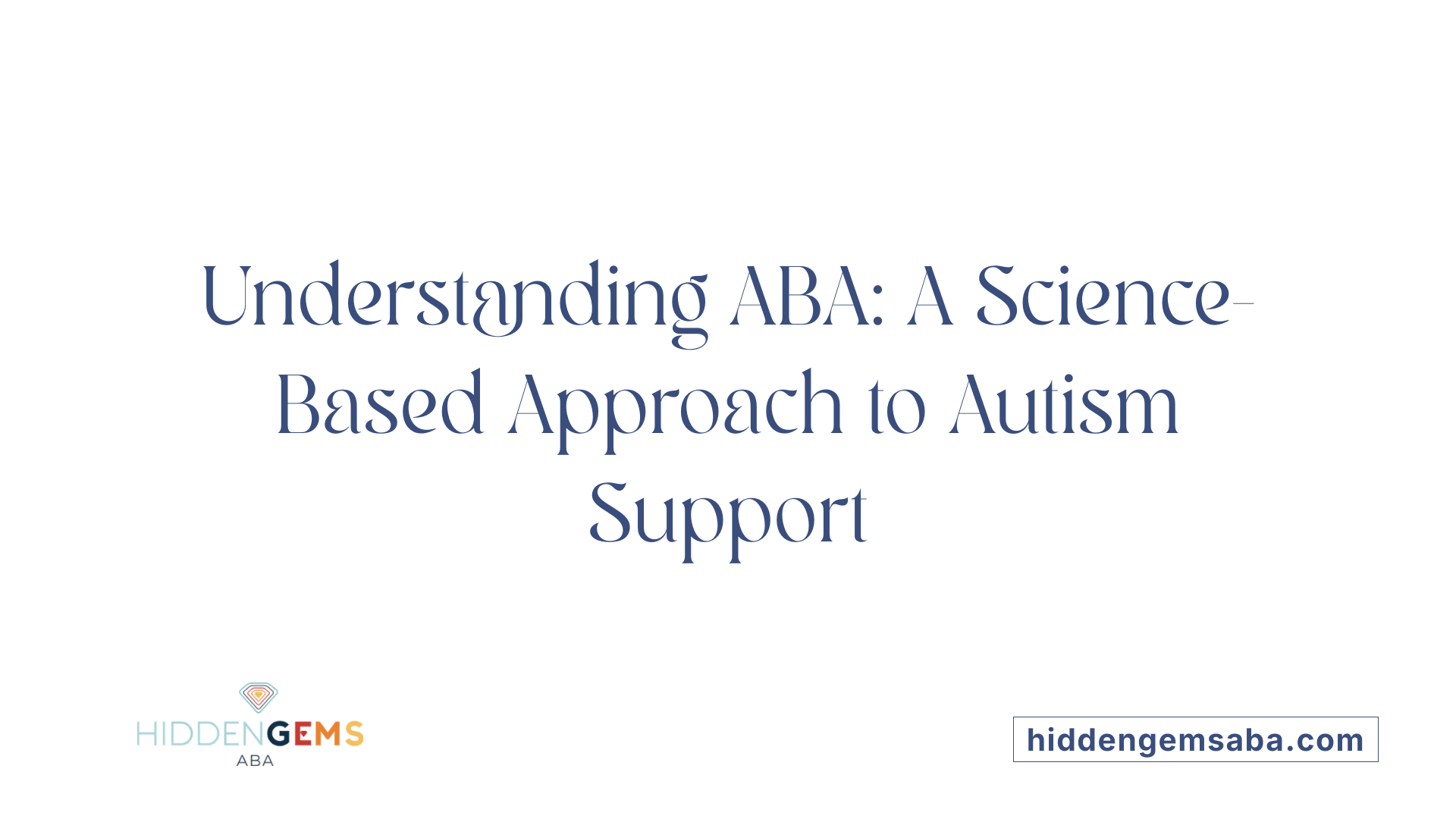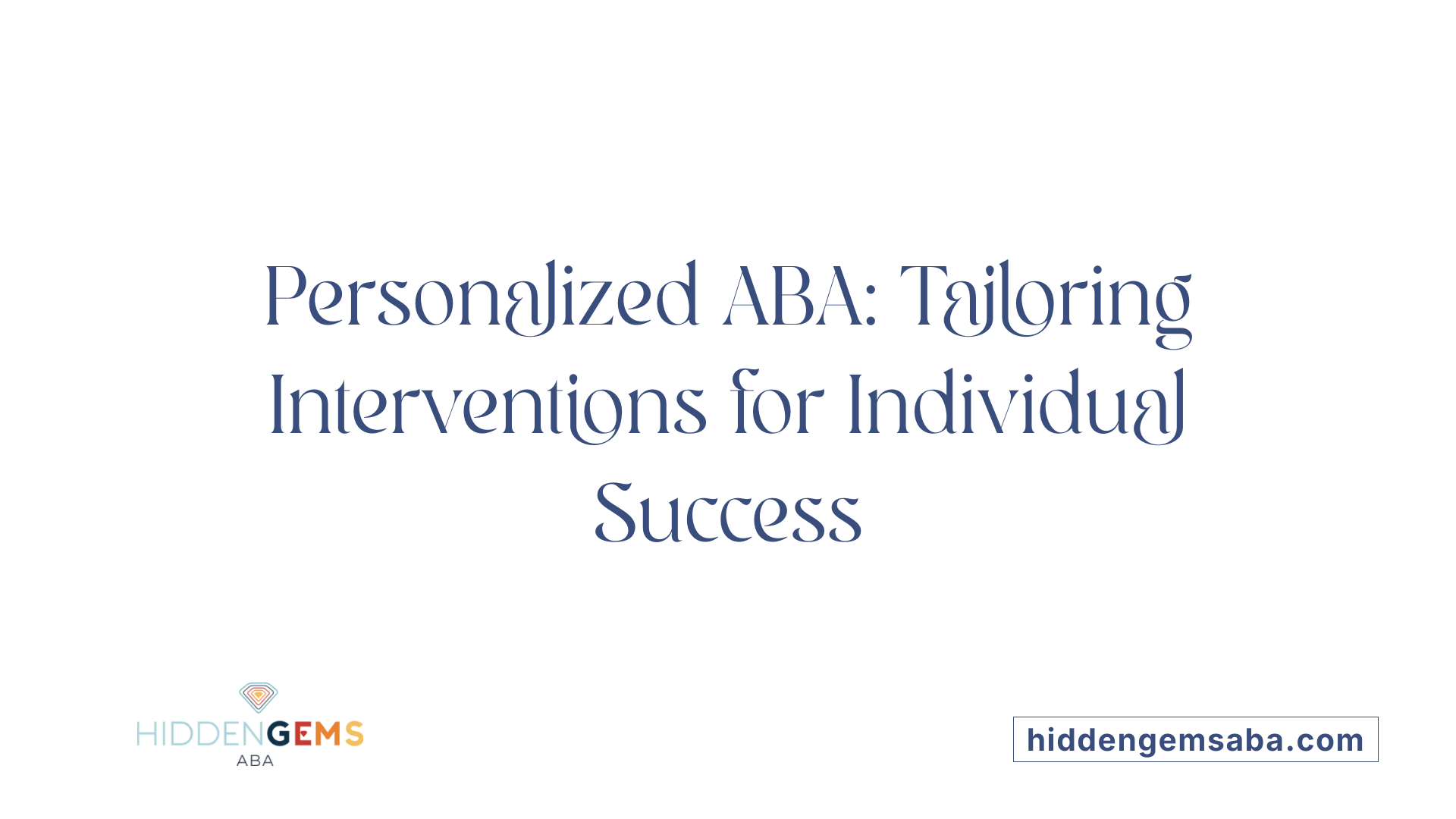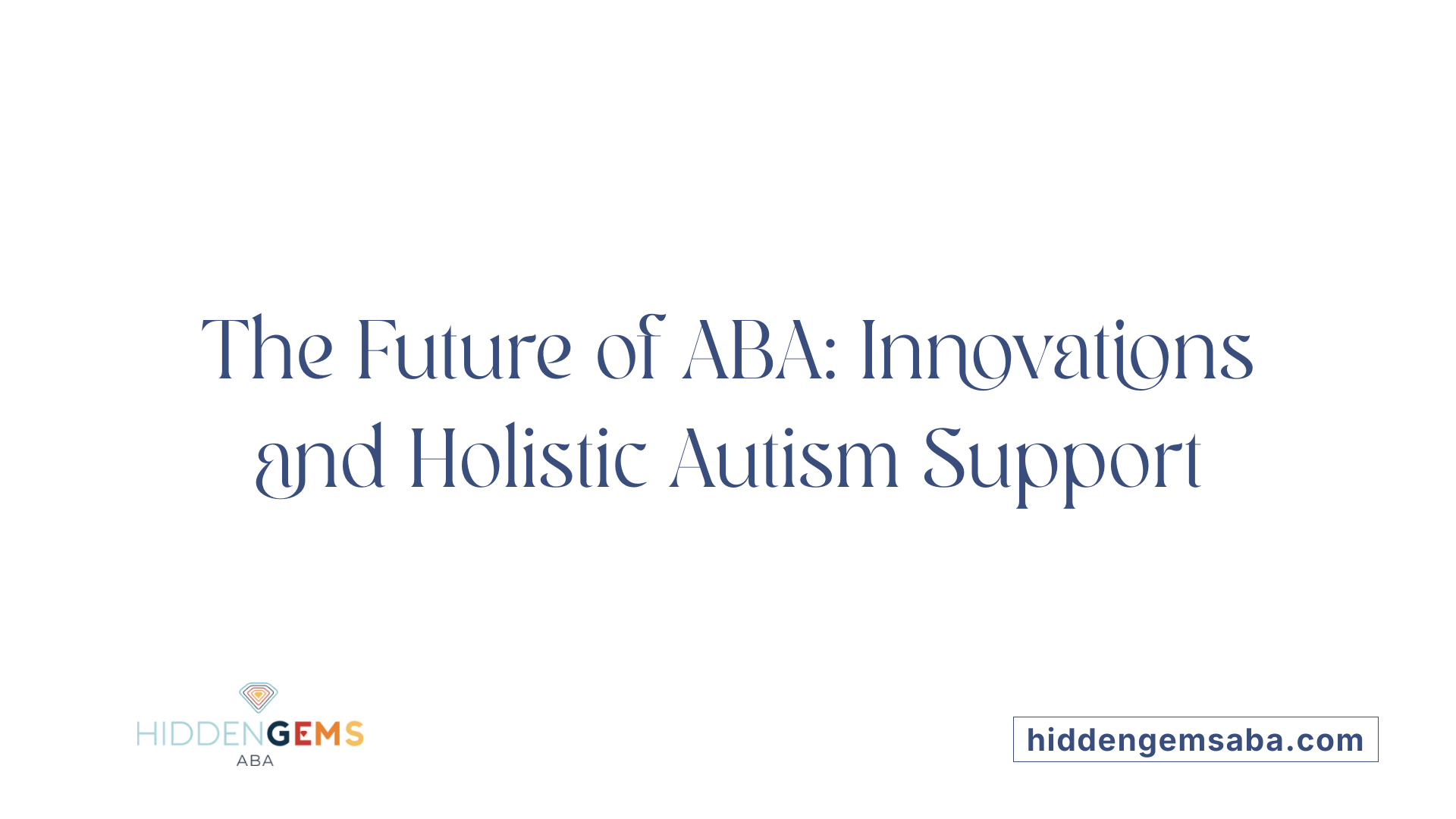Understanding ABA Therapy: A Science-Backed Approach to Autism Treatment
Applied Behavior Analysis (ABA) therapy is a well-established, scientifically supported treatment approach dedicated to improving the lives of children with autism. This article explores what ABA therapy entails, the scientific evidence that supports its effectiveness, the benefits it offers, and the evolving perspectives surrounding its application.
What is ABA Therapy and How Does It Work as a Treatment for Autism?

What is ABA therapy and how does it work as a treatment for autism?
Applied Behavior Analysis (ABA) therapy is a proven, research-based method that helps children with autism improve various skills and reduce challenging behaviors. Rooted in the science of learning and behavior, ABA uses principles like positive reinforcement and environmental analysis to shape desired behaviors.
ABA therapy involves understanding what triggers certain behaviors and how consequences influence future actions. For example, a child's refusal to communicate might be addressed by rewarding attempts at speech, encouraging communication skills to develop.
A trained behavior analyst, often a Board Certified Behavior Analyst (BCBA), designs a personalized treatment program tailored to each child's unique needs. This plan is based on thorough assessments and ongoing data collection to track progress and make adjustments.
The techniques include breaking complex skills into smaller, manageable steps—such as teaching a child to greet someone in steps like eye contact, saying hello, and waving. These steps are practiced repeatedly until the child masters each one.
Additionally, ABA employs methods like prompting—guiding children to perform desired responses—and reinforcement, which rewards behaviors to increase their likelihood. Discrete Trial Training (DTT) is a common structured technique, where instructions are given, responses are reinforced, and learned behaviors are reinforced with praise or treats.
Pivotal Response Treatment (PRT), another approach within ABA, emphasizes naturalistic teaching in everyday settings to improve pivotal skills like motivation and initiation of communication.
The overarching goal of ABA is to help children become more independent, participate fully in society, and improve everyday functioning. It aims to develop skills in vital areas such as communication, social interactions, self-care, play, motor abilities, and academics.
Research consistently shows that intensive early intervention—often 20 to 40 hours per week—can lead to substantial improvements in language, cognition, social skills, and adaptive daily behaviors. ABA's flexibility allows it to be adapted for various ages and developmental stages, making it a central component of autism treatment.
In summary, ABA therapy works by systematically teaching new skills, reducing harmful behaviors, and building on individual strengths, all while continually using data to guide effective intervention strategies. Its evidence-based foundation and adaptability make it a preferred choice for many families seeking supportive therapies for children with autism.
The Scientific Robustness of ABA Therapy
What is the scientific evidence supporting the effectiveness of ABA therapy for individuals with autism?
Applied Behavior Analysis (ABA) therapy is firmly rooted in scientific research. Since its development in the 1960s by Ole Ivar Lovaas, ABA has been extensively studied and refined, establishing a strong evidence base for its effectiveness.
Numerous studies, including large-scale meta-analyses, have consistently shown that ABA can improve important skills such as socialization, communication, and daily living behaviors. These research efforts reveal small to moderate gains in areas like IQ, language skills, and social interactions, with effect sizes ranging from moderate to high. This means that many individuals experience meaningful improvements that can significantly impact their quality of life.
Research involving controlled experiments, such as randomized controlled trials and detailed single-case studies, further reinforce ABA's benefits. Over 435 peer-reviewed publications document its success in reducing problematic behaviors and promoting skill acquisition in children and adults with autism.
Importantly, the benefits of ABA are most pronounced when interventions are early, intensive, and sustained over a period of 12 to 24 months. Young children receiving long-term ABA therapy tend to make larger developmental gains compared to those with shorter or less intensive interventions.
Major health authorities like the US Surgeon General and the American Psychological Association recognize ABA as the most scientifically validated approach for treating autism. This endorsement underscores its status as an evidence-based best practice within the medical and psychological communities.
Continued research supports ABA's capacity not only to modify behaviors but also to enhance social functioning, communication skills, and overall adaptive abilities. As ongoing studies further solidify its scientific foundation, ABA remains a cornerstone of autism treatment worldwide.
Benefits and Outcomes of ABA Therapy
What are the benefits and potential outcomes of ABA therapy for children with autism?
Applied Behavior Analysis (ABA) therapy is a well-established treatment approach that aims to improve various skills and reduce problematic behaviors in children with autism spectrum disorder (ASD). One of the primary benefits of ABA is its ability to foster significant improvements in communication skills. Many children show progress in understanding and using language, which can help them better express their needs and participate in social interactions.
In addition to language development, ABA enhances social skills and behaviors that facilitate better interaction with peers and adults. Objectives often include increasing eye contact, turn-taking, and joint attention — fundamental skills for social engagement.
Behavior management is also a core component. ABA techniques help decrease harmful behaviors such as self-injury, aggression, and tantrums by understanding antecedents and triggers, then modifying responses through reinforcement strategies.
More broadly, ABA promotes the development of essential life skills like self-care, including dressing, eating, and hygiene, which support independence. Academic skills such as early reading and numeracy can also be strengthened through structured, systematic teaching.
Research underscores the effectiveness of ABA, with studies showing that intensive, high-quality therapy affects cognition, language, social functioning, and daily living skills positively.
When therapy begins early, often before age five, and is delivered consistently over 12 to 24 months or more, children often make more substantial gains. It's common for children to achieve levels of independence that enable participation in mainstream settings for some activities.
The overall success of ABA depends on multiple factors, including the therapy’s duration, intensity, family involvement, and individualized goal setting. While outcomes vary among individuals, the evidence supports ABA’s role in improving quality of life, helping children with autism reach their full potential.
Methodologies and Techniques in ABA Therapy

What techniques and methodologies are used in ABA therapy for autism?
Applied Behavior Analysis (ABA) encompasses various scientifically grounded techniques aimed at modifying behavior and fostering skill development. Central to ABA are strategies like positive reinforcement, where desired behaviors are encouraged by rewarding them, effectively increasing the likelihood of their occurrence.
One of the foundational methodologies in ABA is Discrete Trial Training (DTT). This structured approach involves breaking down skills into small, manageable steps, with focused, repeated teaching sessions. During DTT, therapists present clear instructions or prompts, wait for a response, and then provide reinforcement or corrective feedback based on the child's answer.
Another important technique is Pivotal Response Training (PRT). Unlike DTT, PRT emphasizes naturalistic settings, engaging children through play and encouraging pivotal skills such as motivation, initiation of communication, and self-management. PRT aims to produce broad improvements across multiple areas by focusing on these key developmental
ABA Therapy’s Role within Broader Autism Treatments

How does ABA therapy fit within the broader spectrum of autism treatment options?
Applied Behavior Analysis (ABA) is a central, evidence-based approach that is widely recognized for its effectiveness in supporting individuals with autism spectrum disorder (ASD). It is designed to improve essential skills such as communication, social interaction, daily living, and behavior management.
ABA uses principles of learning theory, mainly operant conditioning, to reinforce positive behaviors and reduce harmful or disruptive ones. Its programs are highly personalized, developed by licensed behavior analysts or Board Certified Behavior Analysts (BCBAs), who tailor goals based on each child's strengths, weaknesses, and needs.
While ABA functions as a core intervention, it is generally part of a comprehensive treatment plan that includes other therapies. Speech therapy often complements ABA to improve language skills, while occupational therapy helps develop independence in daily activities. Social skills training and medical management may also be incorporated, depending on individual requirements.
Early, intensive ABA programs—sometimes involving 20 to 40 hours per week—can lead to significant developmental gains, especially when started during early childhood. These gains include improved communication, social responsiveness, and adaptive functioning.
Delivered in various environments such as at home, school, or community settings, ABA's adaptability makes it a foundational element within the broader autism treatment landscape. It is often employed alongside other therapies, creating a multifaceted approach tailored to optimize outcomes.
Overall, ABA not only directly enhances various skills but also supports the integration of children into educational and social settings, fostering independence and better participation in society.
Broader autism treatments in comparison
| Treatment Approach | Focus | Key Characteristics | Setting Example |
|---|---|---|---|
| ABA Therapy | Behavior and skill development | Evidence-based, personalized, goal-oriented | Home, school, community |
| Speech and Language Therapy | Communication skills | Improves understanding and expression | Clinics, schools |
| Occupational Therapy | Daily living and sensory integration | Focus on independence and sensory input | Clinics, home, school |
| Social Skills Training | Social interaction and emotional skills | Structured programs, peer involvement | Schools, social groups |
| Medical Management | Addressing underlying medical issues | Medications, medical evaluations | Clinics, hospitals |
This table illustrates how various treatments work together within the broader spectrum, emphasizing the importance of a personalized, multidisciplinary approach.
Criticisms, Ethical Considerations, and Evolving Perspectives
What are some criticisms and evolving perspectives regarding ABA therapy for autism?
Applied Behavior Analysis (ABA) has been a widely used method for supporting children with autism, but it has also faced significant criticisms over the years. Historically, some ABA practices incorporated punishment and aversive techniques, such as electric shocks or other uncomfortable stimuli, to discourage harmful or undesired behaviors. While these methods have largely been phased out in favor of positive reinforcement and naturalistic strategies, their past use still influences current perceptions of ABA.
One major concern centers around the focus on behavioral compliance. Critics argue that traditional ABA aimed to make autistic children appear more neurotypical through repetitive, task-oriented activities that could cause stress or trauma. This approach sometimes prioritized stopping behaviors like stimming or eye contact, which are natural ways for autistic people to self-regulate and communicate. Such practices risk invalidating the child’s emotional experiences and may lead to masking – where an individual suppresses their true behaviors and feelings to conform to external standards.
In response to these criticisms, many practitioners and researchers have shifted toward more naturalistic, respectful, and individualized approaches. Modern ABA emphasizes building on each child's strengths, interests, and natural environment to foster motivation and meaningful engagement. Play-based interventions and less intrusive methods are now common, aiming to support development while respecting the child's autonomy.
Despite these advancements, debates continue within the autism community. Autism self-advocates and neurodiversity supporters criticize ABA for potentially promoting conformity and discouraging authentic expressions of identity. Some argue that the focus on reducing behaviors seen as 'undesirable' can reinforce societal pressures for autistic individuals to hide their natural traits, which may lead to feelings of shame or lost individuality.
There is also concern about the ethical implications of intense intervention schedules. Critics highlight that overly rigid or high-dose programs can be overwhelming and that some children might experience adverse effects, including increased anxiety or loss of self-confidence.
Meanwhile, the neurodiversity movement advocates for acceptance and understanding of autism as a natural variation of human neurodevelopment. They emphasize that interventions should prioritize the well-being, dignity, and personal preferences of autistic individuals, rather than solely aiming to make them fit into neurotypical norms.
Overall, the evolution of perspectives on ABA reflects a growing acknowledgment of the importance of respecting individual neurodiversity and promoting ethical, person-centered practices. Contemporary approaches aim to balance skill development with respect for the child’s unique identity and emotional health, fostering an environment of acceptance rather than correction.
Highlighting the Personalization of ABA and Its Impact

How is ABA therapy personalized for each individual?
Applied Behavior Analysis (ABA) is not a one-size-fits-all approach. Instead, it is carefully tailored to each person’s unique strengths, needs, and goals. This personalization begins with a comprehensive assessment conducted by a qualified behavior analyst, often a Board Certified Behavior Analyst (BCBA). The BCBA develops a customized treatment plan designed to help the individual develop vital skills like communication, social interaction, and daily living abilities. This plan considers the person's current abilities, interests, and specific challenges, ensuring therapy focuses on areas most relevant to their growth.
What role does a qualified behavior analyst (BCBA) play?
The BCBA is the expert responsible for designing, supervising, and adjusting the individualized ABA program. Their training ensures that the therapy is based on scientific principles and tailored to the person's evolving needs. The BCBA continuously monitors progress, evaluates the effectiveness of the strategies used, and makes real-time adjustments to maximize benefits. Their expertise guarantees that the interventions remain aligned with the individual’s developmental journey, providing a structured yet flexible approach.
How is progress tracked and treatment adjusted?
Data collection is a cornerstone of personalized ABA therapy. Therapists meticulously record the individual’s responses to various interventions. This data-driven approach allows for precise measurement of progress over time. If certain strategies are not producing the desired results, the BCBA reviews the data and modifies the treatment plan accordingly. For example, if a child shows improvement in communication, the focus may shift to more complex social skills. Conversely, if progress stalls, the BCBA may reevaluate and introduce different techniques or modify existing ones to better suit the individual's learning style.
Why is family involvement crucial?
Family members and caregivers play a vital role in the success of ABA therapy. Their active participation ensures that learning continues beyond therapy sessions and into daily routines at home or school. The BCBA provides training and guidance to family members, helping them apply reinforcement strategies and facilitate skill generalization. This collaborative approach fosters consistency, which is essential for meaningful progress. Family involvement also helps in aligning therapy goals with the individual’s daily life, making the process more relevant and sustainable.
| Aspect | Description | Impact on Therapy |
|---|---|---|
| Personalization | Custom treatment plans based on individual strengths and needs | Increases relevance and effectiveness |
| BCBA Role | Experts who design and supervise therapy | Ensures scientific, tailored approaches |
| Progress Tracking | Use of data to monitor and adjust treatment | Maximizes skill development and adapts strategies |
| Family Involvement | Engagement of caregivers in therapy | Enhances consistency and generalization |
This individualized framework ensures that ABA not only promotes meaningful improvements but also respects each person's unique traits and preferences, ultimately supporting greater independence and participation in society.
Conclusion: The Future of ABA Therapy and Autism Support

Continued scientific research and evolving practices
As the field of applied behavior analysis (ABA) continues to grow, ongoing research is essential to refine existing methods and develop new strategies that better serve individuals with autism. Advances in neuroscience, technology, and behavioral science contribute to more personalized and effective interventions. Innovations such as digital tools, virtual reality, and data analytics are enhancing how therapists monitor progress and customize treatments. Over time, the focus is shifting towards more naturalistic, play-based, and holistic approaches, emphasizing not only skill acquisition but also quality of life and well-being.
Integration with other therapies and holistic approaches
Future ABA therapy is likely to become more integrated with other developmental and mental health interventions. Combining ABA with speech therapy, occupational therapy, social skills training, and emotional support can create comprehensive care plans. Embracing holistic approaches that address physical health, sensory needs, and emotional regulation alongside behavioral goals will benefit individuals by supporting all aspects of development. This multi-disciplinary collaboration ensures therapies complement rather than compete, promoting more balanced growth.
Advocacy for ethical and respectful treatment
As awareness grows around potential criticisms of ABA, advocating for ethical practices remains vital. Modern ABA emphasizes respect, individualization, and building on strengths rather than enforcing conformity. Future efforts will focus on promoting informed consent, minimizing coercion, and respecting neurodiversity. Training programs for practitioners will prioritize empathy, cultural competence, and transparency. Critics and advocates alike are working toward models of ABA that honor each person's agency and dignity.
Role of families and communities in supporting progress
Families and communities play crucial roles in the ongoing success of ABA therapy and broader autism support. Empowered with knowledge and resources, parents can advocate for personalized, respectful interventions and contribute actively to therapy goals. Community awareness and acceptance foster environments where autistic individuals can thrive, participate fully, and access inclusive services. The movement increasingly recognizes the importance of peer support, parental involvement, and societal accommodations in enhancing developmental outcomes.
| Aspect | Current Focus | Future Directions | Additional Notes |
|---|---|---|---|
| Scientific Research | Effectiveness, technological integration | New methods, personalized interventions, neurodiversity research | Emphasis on more naturalistic and holistic treatments |
| Therapy Integration | ABA with speech and occupational therapies | More coordinated, multi-disciplinary approaches | Combining strategies for comprehensive support |
| Ethical Standards | Respect, consent, individualized care | Increased awareness, practitioner training, respect for neurodiversity | Balancing intervention with dignity |
| Family and Community Roles | Support, advocacy, in-home therapy | Greater community involvement, peer support, societal acceptance | Factors influencing lifelong success |
As these future trends unfold, the overarching goal remains clear: to support autistic individuals in achieving their fullest potential while respecting their unique identities. Ongoing innovation, ethical commitment, and community participation will shape the landscape of autism support well into the future.
Empowering Individuals and Families Through Evidence-Based Support
As ABA therapy continues to evolve, it remains a cornerstone of autism intervention, grounded in scientific research and personalized to individual needs. Emphasizing ethical, respectful practices and integrating other supportive therapies, ABA has the potential to significantly enhance quality of life for children with autism and their families. Ongoing advocacy, innovation, and respect for neurodiversity are shaping a future where all individuals can reach their full potential through compassionate, evidence-based care.






